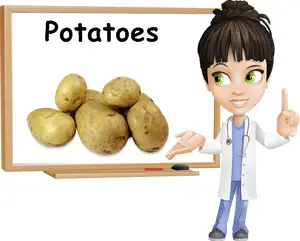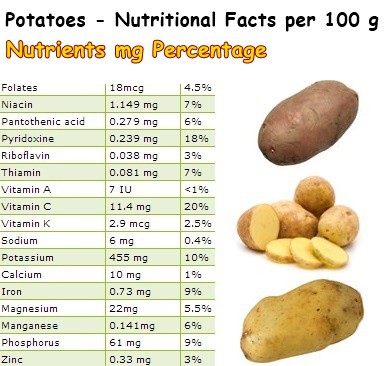Despite their good nutritional profile and exceptional culinary versatility, potatoes (Solanum tuberosum) are easily misjudged and labelled as the poor man’s food. For this reason, many people often avoid eating them for fear of being judged as having poor taste and little money. In reality, potatoes are extremely beneficial for our health. They are a good source of dietary fiber, starch, vitamins and minerals, notably vitamin C and potassium.
Moreover, they are an alkaline vegetable, meaning they help preserve a delicate balance within our body that contributes to better health. Regular consumption of potatoes can help lower high blood pressure and regulate blood sugar. The vegetable is also a good source of B vitamins that contribute to good digestion and support brain and nervous system activity. Potatoes are even great for morning sickness and skin problems such as acne due to their good pyridoxine content.

About potatoes
Just like peanuts, potatoes grow underground, which makes them tubers. They are basically a storage vegetable that gathers essential nutrients which are meant ensure the survival of the plant during winter. Impressive, right? And we just dig them out and collect the rich reserves of nutrients found within. Potatoes are quite easy to identify.
What do potatoes look like?
There probably isn’t a person in this world who does not know what a potato looks like. Round, oval, slightly rectangular or incredibly odd-shaped, varying immensely in size (think cherry tomato to huge quince size) and color, texture and even taste. The skin ranges in color from a dull yellow to pink, light brown to red, light and dark purple and dark-brown. Common yellow-skinned varieties have a light, creamy flesh, while darker ones have a darker flesh. Depending on the variety, potatoes may have either a hard or a soft texture after being cooked.
What do potatoes taste like?
Potatoes have a rather bland taste overall but compensate for it with their creamy texture. They taste is more or less starchy, depending on the variety and how they are cooked, but there are some faint flavor notes too, sometimes sweet and sometimes slightly nutty, depending on the variety. The good part about their taste is that they compliment a variety of dishes with different flavors and textures, acting as the perfect side dish to support more flavorful, hearty and heavily seasoned meals.
Potato recipe ideas
My favorite two recipes are mashed potatoes and potato and bell pepper stew. I like my mashed potatoes to be soft and thick, and mashed very finely. I usually add a pinch of salt, a spoon of either cold pressed sunflower oil or butter and a generous serving of hot cow’s milk. And potato stew tastes absolutely incredible: cut the potatoes into big chunks and boil together with red, yellow and green bell peppers and a fried onion, season with a pinch of salt, pepper, some vegetable oil and top off the dish with lots of fresh parsley. I usually like a bit of texture to my vegetables, so I add the peppers later and don’t cook the vegetables until they are mushy.

But why should we eat potatoes when there is such a variety of more nutritious and savory vegetables to choose from? Potatoes are not only easy to cook and grow, cheap and versatile, they are also quite healthy. I’m not saying you should eat them every day, but remember that diet variety does wonders for your health. See below my 7 reasons why potatoes are good for you.
What are the benefits of potatoes?
Moderate source of calories
100 g of potatoes supplies us with only 70 kilocalories (kcal) and less than 0.1% fat. Despite many condemning them, potatoes may actually help you lose weight, provided you don’t deep fry them. I often like to eat 1-2 medium sized boiled potatoes with either fresh cow or goat cheese (new cheese that is not ripened) and fresh parsley or cut into chunks and made into a salad together with 1-2 boiled eggs, olives and leek. Simple, nutritious and waist-friendly.
Heart-friendly food
Potatoes contain good amounts of dietary fiber (2.5 g/100 g), no fat, no cholesterol and, more important, potassium (10% of the RDA). Fiber prevents too much fat from the foods we eat from being absorbed at the intestinal level and then entering the bloodstream and thus indirectly contributes to lowering blood cholesterol levels. By regulating body fluids, potassium manages to lower high blood pressure and maintain cardiovascular health.
See also : Can Potatoes Cause Constipation?

Good for colon health, relieves constipation
Potatoes are best known for their high starch content. Starch is a carbohydrate thought to resist digestion enzymes. As a result, it passes unmodified through the digestive tract, similar to fiber. This helps add bulk to stools, facilitating more frequent bowel movements and relieving constipation. Moreover, studies suggest that limiting the time our colon is exposed to toxins in waste material (as a result of constipation) can have beneficial, long-term effects on colon health. Boiling potatoes increases their starch content significantly.
Helps regulate blood sugar levels
The good amount of starch in potatoes plays an essential role in regulating post-meal blood glucose levels and preventing blood sugar spikes that cause fluctuating energy levels and ultimately, fatigue. However, intake is crucial and potatoes are only meant to be consumed in reasonable amounts. If you are diabetic, pair potatoes with a source of protein such as hard boiled eggs, and maybe some mayonnaise (also brined black olives and green onions) to avoid spikes in blood sugar.
Good source of B vitamins and other essential nutrients
Potatoes contain vitamins B1, B2, B3, B5 and B6, as well as small to moderate amounts of potassium, iron, phosphorus, manganese, magnesium and zinc. B vitamins contribute to carbohydrate synthesis, support nerve cell health, cognitive development, digestion and reduce inflammation levels. Phosphorus and magnesium are great for bone health, while manganese supports thyroid hormone production, provides antioxidant protection and improves fertility. Pyridoxine (vitamin B6) may also help with morning sickness.
Good source of vitamin C
Potatoes provide 20% of the RDA of vitamin C, a potent antioxidant, antimicrobial and anti-inflammatory agent. Vitamin C boosts immunity, reduces inflammation and promotes collagen production, delaying wrinkles. Interesting enough, researched has revealed that potato skin contains even more vitamin C than the flesh. However, cooking potatoes for longer periods of time can cause them to lose most of their vitamin C content.
Exhibits antioxidant activity
Yes, the humble potato contains antioxidants-proper which hunt down free radicals and destroy them before they can damage healthy cells and cause them to mutate into cancerous one. Potatoes contain polyphenols such as chlorogenic acid (which also positively influences blood glucose levels and prevents retina damage), neo-chlorogenic acid as well as carotenoids (especially in red-skinned varieties) and anthocyanins (in purple varieties).
In addition to this, red-skinned potatoes have been shown to have a higher content of vitamin A and zeaxanthin, an antioxidant required for retina health and good vision. Zeaxanthin physically accumulates in the retina where it acts like a shield, absorbing radiation from light and preventing it from damaging our eyesight.
Conclusion
Overall, potatoes are healthy and thus worth being included in our diet. Nevertheless, always avoid purchasing and eating green potatoes. The patches of green on potato skins and potato flesh are indicative of toxic glycoalkaloids such as solanine and alpha-chaconine. Glycoalkaloids occur naturally in the parts of the potato exposed to sunlight (stems, leaves and flowers) and, to a lesser extent, on the tubers that normally grow underground.
Leaving potatoes in direct sunlight, on the balcony for example, causes chlorophyll to accumulate in the areas full of glycoalkaloids, indicating those parts ought to be discarded (although this may not always occur). Eating green potatoes may cause gastrointestinal upset with symptoms such as diarrhea, nausea, vomiting, abdominal cramps and discomfort. Some people are more sensitive to the effects of these compounds in the vegetable than others. Even so, cutting out the green parts might be best because glycoalkaloids are, after all, toxic and may produce unpleasant, though not necessarily serious side effects.
